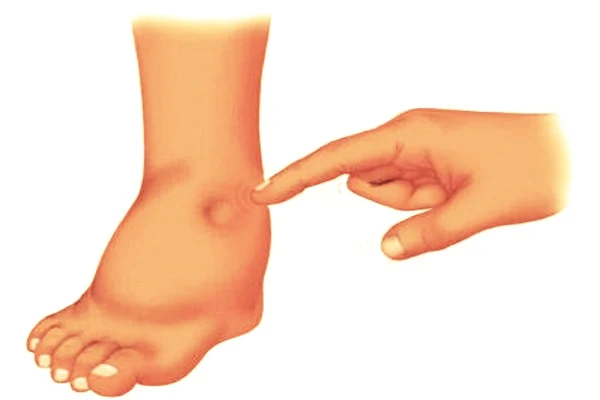Edema is a medical term for swelling which occurs when small blood vessels leak fluid into nearby tissues.
What is the
Difference between Pitting Edema and Non-Pitting Edema?
What is Edema?
Pitting Edema:
Non-Pitting
Edema:
Read also:
1. Neuropathy: Types, Symptoms and Causes
2. Neuropathy-Diagnosis and Treatment Methods
3. Cerebral Edema (Brain Swelling) - Types, Symptoms, Causes and Treatment
When the swollen skin is pressed with a finger and this may leave a pit in the skin, this is called pitting edema. When the swollen area is pressed and it doesn’t leave a pit in the skin, this is called non-pitting edema.
 |
| Normal foot and foot with edema |
What is the
Difference between Pitting Edema and Non-Pitting Edema?
What is Edema?
Edema is a swelling which occurs when the fluid that accumulates in the
body's tissues leads to fluid retention or swelling.
Water makes
up about 60% of the human body weight. Normally, the majority of the amount of
water is inside the cells of the body, and about a third of this amount is
outside the cells, while about 25% of this amount constitutes blood fluid
(plasma), and the rest of the intercellular fluid.
Edema is
characterized by an increase in the amount of cytoplasm (the fluid inside the
cell). Edema can be
seen in the outward appearance only after a few liters of liquid have
accumulated.
Edema is swelling that occurs when small blood vessels leak fluid into nearby tissues. If you are one of those people who are suffering from this condition, then take help from a doctor even if it is online. For taking online help, visit Helpcare+, as they have the best doctors.
Edema
appears as local swelling, for example: edema of the abdominal cavity called
"ascites", edema of the pleura (The pleura is a thin, fine
serous membrane, covering the lungs (visceral pleura) and lining
the thoracic cavity (parietal pleura).
There are
many things that may cause edema such as warm weather, thyroid conditions,
lymphatic system, etc. Edema is classified as pitting edema and non-pitting
edema.
Pitting Edema vs. Non-Pitting Edema
Pitting Edema:
 |
| Pitting edema |
What is Pitting Edema?
When the swollen skin is pressed, it
may leave a pit in the skin, this is called pitting edema, so it responds well
to elevation and diuretics.
Pitting edema is either caused by
systemic problems with your heart, kidneys, or liver function or a localized
problem with veins in the affected area.
Pitting edema can occur anywhere on
the body but it generally affects areas of the lower body including the feet,
legs, and ankles.
Pitting edema is most common in the
lower body, particularly in the legs, feet, and ankles.
Swelling in your body can usually
make the skin feel tight, sore, or heavy due to extra fluid collecting in
it.
Symptoms of pitting edema occur case
by case, depending on the cause, but they may include:
- Pain and aching in the swollen areas
- Heart murmur, chest pain or swelling in the limb
- Skin that is warm or hot to the touch
- Skin that feels puffy or stiff
- Shortness of breath and unexplained coughing
- Tingling or burning sensations around the swelling
- Fatigue or decreased stamina
- Numbness and cramps
- Bloating and water retention
- Low blood protein, especially if the swelling is in your abdomen
Pitting edema is caused by a variety
of issues such as: low protein levels, heart valve problems, deep venous
thrombosis (DVT), venous insufficiency, congestive heart failure, kidney
failure, severe lung disease and liver disease.
Non-Pitting
Edema:
 |
| Non-pitting edema |
What is Non-Pitting Edema?
When the swollen area is pressed
with a finger and it doesn’t leave a pit in the skin, this is called
non-pitting edema.
In non-pitting edema, once the pressure is removed, the skin returns to its swollen shape and does not create
an indentation in the skin.
Non-pitting edema can be diagnosed
very easily because it is more likely to be caused by three specific
conditions:: lymphedema, myxedema, and lipedema.
Lymphedema
Lymphedema is swelling in one of
your arms or legs due to the build-up of lymph fluid in the body or lymphatic
system blockage. Sometimes swelling occurs in both arms or both legs.
Some people are born with lymphedema
while others develop it after surgery or as a secondary condition to a bigger
issue.
Myxedema
Myxedema refers to skin swelling and
inflammation of the soft tissue that occurs when your body does not produce
enough thyroid hormone.
Most people with myxedema suffer
from hypothyroidism – both severe and advanced cases.
Lipedema
Lipedema is a disorder that results
in non-pitting edema. Lipedema usually occurs in women, almost exclusively and
it is characterized by symmetrical enlargement of the legs due to the
accumulation of fat under the skin.
When fat cells build up abnormally
in the hips, buttocks, and legs, they tend to retain more fluid.
1. Neuropathy: Types, Symptoms and Causes
2. Neuropathy-Diagnosis and Treatment Methods
3. Cerebral Edema (Brain Swelling) - Types, Symptoms, Causes and Treatment
